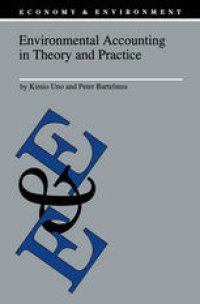
Ebook: Environmental Accounting in Theory and Practice
- Tags: Environmental Economics, Economic Growth, Macroeconomics/Monetary Economics
- Series: Economy & Environment 11
- Year: 1998
- Publisher: Springer Netherlands
- Edition: 1
- Language: English
- pdf
Policy failures in environment and development have been blamed on frag mented and eclectic policies and strategies. The 1992 United Nations Con ference on Environment and Development, the 'Earth Summit' in Rio de Janeiro, called therefore for an integrated approach in planning and policy making to achieve long-term sustainable growth and development. The Con ference also recognized in its action plan, the Agenda 21, that integrated poli cies need to be supported by integrated information, notably requiring the implementation of integrated environmental and economic accounting by its member States. During the preparations for the Rio Summit, scientists and practitioners of national accounting met in a Special Conference on Environmental Account ing, organized by the International Association for Research in Income and Wealth (IARIW) in Baden, Austria. Their aim was to explore the need for and methodologies of adjusting national accounts for environmental reasons. National accountants had faced mounting criticism that conventional accounting neglected new scarcities in natural capital, as well as the social cost of environmental degradation. The result of their deliberations was a draft manual, later issued by the United Nations Statistics Division (UNSD) as a handbook of Integrated Environmental and Economic Accounting.
The global community is increasingly preoccupied with the concept of sustainability, to the extent that the traditional measure of gross domestic product (GDP) is giving way to a `green GDP'. Many attempts have also been made to measure the degradation of the environment and the depletion of natural resources.
Environmental Accounting in Theory and Practice presents a comprehensive picture of the most modern research issues in the field, based on the experience of many countries with the introduction of integrated environmental and economic statistics, including physical accounting methods for material flows and spatial accounting for land use. Theoretical issues concerning the valuation of environmental goods and the concept of sustainability are also discussed.
The 20 chapters in the book have been written by representatives of major international institutions, national statistical offices, research institutes and universities in Europe, the USA, Canada and Asia. Together with the comprehensive bibliography and the index, they form a state of the art report on the greening of the global economy.